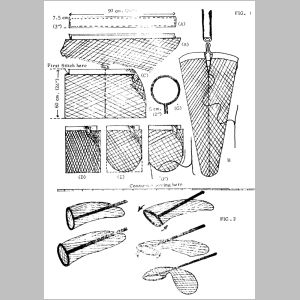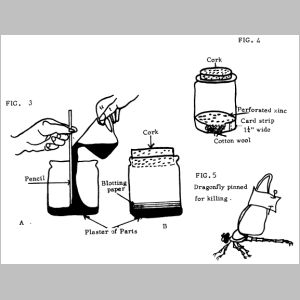Bulletin 13 - March 1981: Insect Collecting -- Killing Bottles
Insect Collecting -- Killing Bottles
by D. DonohuePreparing the bottle is quite simple. First place a cup of cold water in a small jug and add Plaster of Paris powder, stirring all the time until the mixture is thick and creamy. Immediately this is done, support a pencil, almost vertically, in the center of the bottle, with one end resting on the bottom. Now pour the liquid plaster down the side of the pencil until it forms a layer in the bottom of the bottle about 0.75in thick (Figure 3A). Finally, withdraw the pencil taking care not to touch against the side of the bottle while doing so.
The bottle should remain where it is until the plaster is set, but in any case it must be left uncovered for several days for the plaster to become really dry. Before putting the bottle to use, cut a few disks from blotting paper and fit these into it so that they cover the plaster surface. (Figure 3B).
When mixing Plaster of Paris, it does start setting almost as soon as the mixture is made, so that there should be no delay in transferring it to the bottle.
To make the alternative type, you will require a strip of stout card at least 3cm wide and of sufficient length to enable it to be inserted in the bottle and form a ring at the bottom. Within this ring, place a tight packing of cotton wool, and cut a disk of perforated zinc to fit the internal measurement of your bottle. This disk is inserted and allowed to rest on the edge of the card ring. It is sometimes difficult to make the zinc disk fit tightly and to overcome the possibility of it being displaced; the container should be kept in an upright position (Figure 4).
With either bottle you can use Ethyl Acetate or Carbon Tetrachloride and when required for use, a little of the selected chemical is inserted with a medicine dropper and allowed to soak into the plaster or cotton wool.
In the field you will find the killing power of the bottle decreases due to the escape of vapor when the bung or lid is continually removed to admit specimens. Thus it will be necessary to add more chemical at fairly frequent intervals.
When collecting it is useful to use two killing bottles suitably charged with chemical. One is kept in a pocket and in this the specimen is stupefied. It is then transferred to the other bottle, contained in a haversack or similar container and, if possible, kept away from the heat of the sun. A piece of tissue is laid over the insect and the next specimen, after being rendered motionless in the first bottle, is placed on the tissue and is itself covered with tissue. If the bottle has to be carried any distance before specimens can be dealt with, the use of tissue prevents them from rubbing against each other. By adopting this method, no time is lost in waiting for an insect to expire completely.
The insects will succumb to the poison vapor fairly quickly, but leave them exposed to it for about 15 minutes after all movement has ceased to make sure that they are dead.
Laurel leaves can be employed for killing insects, but it is important to have common or cherry laurel (Prunus laurocerasus). Use only fresh young leaves and these must be quite dry and chopped finely with a knife. When the leaves are well chopped, place them in a little cloth bag then lay it on a piece of wood and hit it repeatedly with a block of wood. This will bruise the leaf fragments and cause them to give off prussic acid gas, which as a smell rather similar to that of bitter almonds.
The second type of killing bottle described can be modified for use with Laurel by omitting the cotton wool and packing the cavity with bruised leaves to a depth of 1in or so. The cork bung or screw lid is then replaced and the bottle set aside for at least a day, after which it is ready for use. During this resting period, in which fermentation of the leaves takes place, it is a good idea to include, as a temporary measure, a few strips of blotting paper to absorb any liberated moisture which would otherwise condense on the sides of the bottle. These strips are, of course, removed and discarded prior to putting the bottle into service.
An alternative and very effective way of preparing the leaves is to put them through a mincing machine as this chops them finely and bruises them at the same time. However, once used, the machine must not be allowed to come into contact with foodstuffs, and hands, implements -- anything used in the preparation -- should be thoroughly washed.
The gas given off from Laurel leaves is sufficiently strong to kill, but it takes a little time to do so. A great advantage of Laurel is that the insects can be left in the bottle where they will remain perfectly relaxed and without harm until reaching home, when they can be set immediately.
Carbon tetrachloride is a good killing agent, but it leaves specimens hard. Proprietary brands of killing fluid are possibly the best as these are made up with a mixture of chemicals to achieve a more rapid knockout effect, so that an insect is killed before it has time to damage itself. However, I doubt it this can be purchased in Abu Dhabi.
For killing beetles and insects that do not fly, plain ethyl acetate is ideal. It has the advantage of keeping the insects in a relaxed condition. It should not be used as an anaesthetic for either butterflies or moths, for it is far too slow in its action; a butterfly can flap a lot in the few extra seconds involved. Laurel leaves are also too slow for killing butterflies and moths. Ethyl acetate could be used but it should be injected into the thorax from underneath using a very tiny drop of fluid and a small hypodermic syringe. In fact, the plunger should hardly be moved at all, slight pressure being all that is required. this method is ideal for killing the large moths such as the Hawks.
Beetles killed by ethyl acetate will stiffen slightly after death, but if allowed to remain within the bottle for 12 hours or so, they will be sufficiently limp and relaxed for setting. Those killed with Laurel leaves can remain in the bottle for several days, if necessary, without coming to any harm, and they will be quite relaxed and present no difficulty when you come to the task of setting them.
Some of the larger beetles are not easily killed. These species can be killed quickly if dropped into very hot water, where they need only remain for a few seconds. They are then dried on blotting paper and transferred to a relaxing tin. However, this sometimes caused their wings to open and it may be difficult to restore these to their natural folded position.
Ordinary household ammonia has been recommended for killing butterflies and moths although this can sometimes alter their color, notably blue, red, brown and green, so it is not an ideal agent.
Another way of killing Lepidoptera is by pinching the thorax between thumb and finger in one neat, quick, decisive movement. this is a knack, and is learned only with practice. Its advantage is that it kills the insect instantaneously without giving it a chance to struggle and break its wings, or knock off any scales. Naturally, it is only a worthwhile method if the pinching is expert enough to kill the insect quickly and with less damage than using the killing bottle.
For killing dragonflies, laurel and ammonia are recommended, the latter in conjunction with the Plaster of Paris or cotton wool packed bottles. Ethyl acetate is unsuitable for the Odanata and must not be used.
Before killing any species of Hawker or Darter Dragonfly, it is advisable to fasten the wings over the back with a strip of paper held in place with a fine pin (Figure 5). This will prevent the insect from fluttering in the bottle and damaging its wings. The same pre-killing treatment can be given to the larger damselflies but it is not necessary to do so with smaller species.
Dragonflies should be stored alive in the jar for about 24 hours before killing, otherwise they will lose all their color. they catch small insects as food and their bodies will be packed with the remains, which will decay when the insect is killed and turn it quite dark. It may lose the bright coloring but the pattern markings will be there to study.
Soft bodied insects such as Ichneumon Flies etc can be dropped into a diluted mixture of Formalin (nine parts water to one part Formalin). In its struggle against asphyxiation, it will swallow the liquid and therefore allow complete penetration; however, this method is slow and not particularly pleasant for the insect or for the Collector to watch!
Entomologists frequently make use of sodium cyanide or potassium cyanide in killing bottles, and without doubt there is much to be said in favor of cyanide. However, it is one of the deadliest poisons, and bottles containing this chemical should only be used by professionals.
It is essential to examine carefully all insects you catch and to do this either while they are still in the net or immediately after you have placed them in the killing bottle. If they appear to be rare or in any way worn or ragged, then release them at once. Even if they are actually in the killing bottle, the amount of gas taken into the body is insufficient to kill, and by releasing them they will be free to carry on the species.
In addition, never take more of one species than is absolutely necessary for the making of a representative collection. We have a policy of taking two specimens of each species -- one for the Group's record and a spare in case we wish to send one to England for identification. An additional specimen could be taken for a personal collection, but three should be the absolute maximum.

